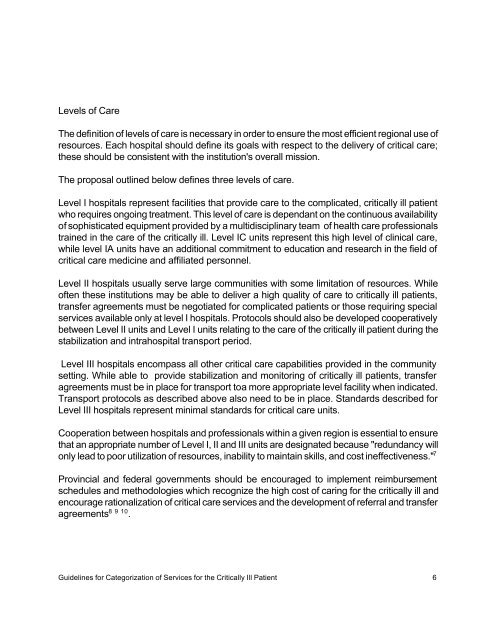Guidelines for Categorization of Services for the Critically Ill Patient
Guidelines for Categorization of Services for the Critically Ill Patient
Guidelines for Categorization of Services for the Critically Ill Patient
You also want an ePaper? Increase the reach of your titles
YUMPU automatically turns print PDFs into web optimized ePapers that Google loves.
Levels <strong>of</strong> Care<br />
The definition <strong>of</strong> levels <strong>of</strong> care is necessary in order to ensure <strong>the</strong> most efficient regional use <strong>of</strong><br />
resources. Each hospital should define its goals with respect to <strong>the</strong> delivery <strong>of</strong> critical care;<br />
<strong>the</strong>se should be consistent with <strong>the</strong> institution's overall mission.<br />
The proposal outlined below defines three levels <strong>of</strong> care.<br />
Level I hospitals represent facilities that provide care to <strong>the</strong> complicated, critically ill patient<br />
who requires ongoing treatment. This level <strong>of</strong> care is dependant on <strong>the</strong> continuous availability<br />
<strong>of</strong> sophisticated equipment provided by a multidisciplinary team <strong>of</strong> health care pr<strong>of</strong>essionals<br />
trained in <strong>the</strong> care <strong>of</strong> <strong>the</strong> critically ill. Level IC units represent this high level <strong>of</strong> clinical care,<br />
while level IA units have an additional commitment to education and research in <strong>the</strong> field <strong>of</strong><br />
critical care medicine and affiliated personnel.<br />
Level II hospitals usually serve large communities with some limitation <strong>of</strong> resources. While<br />
<strong>of</strong>ten <strong>the</strong>se institutions may be able to deliver a high quality <strong>of</strong> care to critically ill patients,<br />
transfer agreements must be negotiated <strong>for</strong> complicated patients or those requiring special<br />
services available only at level I hospitals. Protocols should also be developed cooperatively<br />
between Level II units and Level I units relating to <strong>the</strong> care <strong>of</strong> <strong>the</strong> critically ill patient during <strong>the</strong><br />
stabilization and intrahospital transport period.<br />
Level III hospitals encompass all o<strong>the</strong>r critical care capabilities provided in <strong>the</strong> community<br />
setting. While able to provide stabilization and monitoring <strong>of</strong> critically ill patients, transfer<br />
agreements must be in place <strong>for</strong> transport to a more appropriate level facility when indicated.<br />
Transport protocols as described above also need to be in place. Standards described <strong>for</strong><br />
Level III hospitals represent minimal standards <strong>for</strong> critical care units.<br />
Cooperation between hospitals and pr<strong>of</strong>essionals within a given region is essential to ensure<br />
that an appropriate number <strong>of</strong> Level I, II and III units are designated because "redundancy will<br />
only lead to poor utilization <strong>of</strong> resources, inability to maintain skills, and cost ineffectiveness." 7<br />
Provincial and federal governments should be encouraged to implement reimbursement<br />
schedules and methodologies which recognize <strong>the</strong> high cost <strong>of</strong> caring <strong>for</strong> <strong>the</strong> critically ill and<br />
encourage rationalization <strong>of</strong> critical care services and <strong>the</strong> development <strong>of</strong> referral and transfer<br />
agreements 8 9 10 .<br />
<strong>Guidelines</strong> <strong>for</strong> <strong>Categorization</strong> <strong>of</strong> <strong>Services</strong> <strong>for</strong> <strong>the</strong> <strong>Critically</strong> <strong>Ill</strong> <strong>Patient</strong> 6


